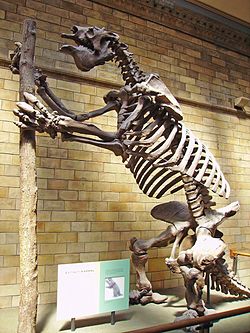Megafauna

Megafauna are large animals. The word is most used for the Pleistocene megafauna – the large land animals of the last ice age, such as mammoths.[1] It is also used for the largest living wild land animals, especially elephants, giraffes, hippopotamus, rhinoceros, elk, condors, etc.
Its use is connected with the discussion about the Holocene extinctions after the ice age. Most of the large land animals which were alive 12,000 years ago are now extinct, and there is much discussion as to what has caused this. The two main theories are hunting by humans, and climate change.[2] Together, these reasons are enough to explain why these previously successful animals are now extinct. Elephant birds on Madagascar were certainly hunted to extinction, as were the Moas in New Zealand. Archaeological sites with evidence of moa hunting are all over New Zealand. The moas became extinct about five hundred years ago.[2] The moas had survived being hunted by Haast's Eagle, but they did not survive being hunted for food by the Maoris.
For many others the climate changes may have been the main reason for their extinction.
Megafauna Media
The African bush elephant (foreground), Earth's largest extant land animal, and the Masai ostrich (background), one of Earth's largest extant birds
Large terrestrial mammals compared in size to one of the largest sauropod dinosaurs, Patagotitan
- A size comparison between a human and 4 moa species: 1. Dinornis novaezealandiae 2. Emeus crassus 3. Anomalopteryx didiformis 4. Dinornis robustus
Cyclical pattern of global climate change over the last 450,000 years (based on Antarctic temperatures and global ice volume), showing that there were no unique climatic events that would account for any of the megafaunal extinction pulses
American lions (Panthera atrox)
References
- ↑ Ice age animals. Illinois State Museum
- ↑ 2.0 2.1 Martin P.S. & Klein R.G. (eds) 1984. Quarternary extinctions: a prehistoric revolution. Tucson: Arizona University Press. ISBN 0-8165-1100-4










